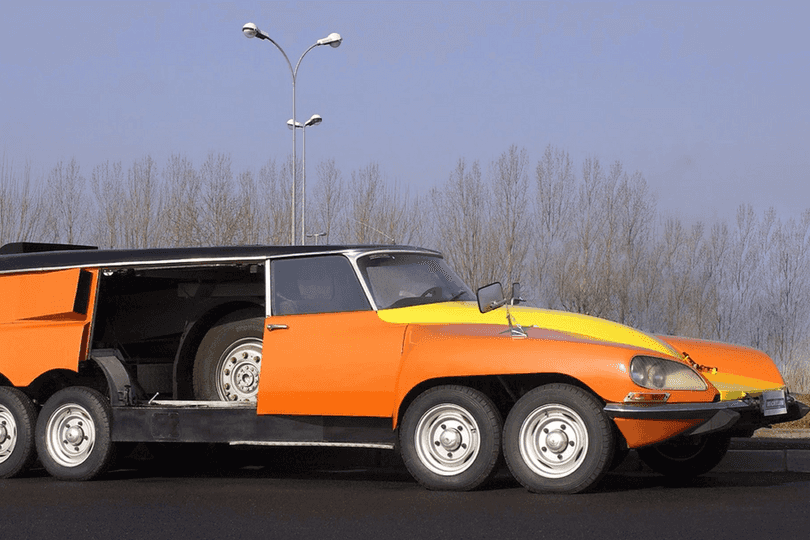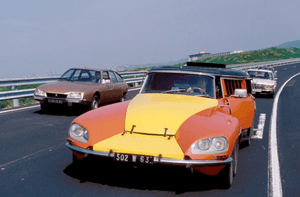How’s this for digging up strange vehicle builds from the history books? Michelin built this 10-wheeled machine back in 1972 to use as a test vehicle for the company’s commercial tires. The custom Citroen’s official name is “Poids Lourd Rapide,” which loosely translates to “fast truck” or “heavy weight fast” in English. The Citroen PLR, as unique as it is, carries many other nicknames such as the Citroen Centipede, the Mille Pattes, or simply “the Michelin test car.”
The truck tire tester weighs in at over ten tons and is capable of 500 horsepower with 11 tires touching the ground. It was able to test commercial truck tires at 110 miles-per-hour. Inside the nearly 23-foot-long elongated body is a contraption that accommodates the larger 11th tire, the main test subject and the hidden secret of the Citroen PLR.
Using a front-engine, front-wheel-drive Citroen DS platform as the starting point, Michelin took bodywork from the DS Safari as inspiration for the intensive custom build. The 10 wheels visible from the outside were sourced from a commercial Citroen H van and are used for the vehicle’s core operation, the front four being used for steering and the rear six being drive wheels.
Dual GM Power Propels the Citroen Forward
According to Michelin, the whole thing is powered by two rear-mounted GM 5.7-liter small-block V8 engines, each capable of hitting around 250 horsepower from the factory, so the combined horsepower reaches up to approximately 500 ponies, enough to push this 21,000-pound machine forward to a top speed of 111 miles-per-hour. It took five vertically stacked radiators to cool the engines, plus bodywork designed to direct airflow accordingly. The beast was also fuel hungry and drank from two dual 23-gallon fuel tanks.
One of the two engines sent power to the three rear Peugeot 504-sourced drive axles, while the other put all its power to the single hidden 11th wheel. The idea behind the hidden wheel was to allow Michelin to mount a large commercial tire in the center and bring it up to top speed without worrying about a blowout ruining the rest of their ride.
The 11th wheel was fitted on a swing arm and could be hydraulically lowered and adjusted to different angles during the test drive. Engineers were able to adjust the speed and braking of the single wheel, and also the load and drift to test the tires in every condition. A hydraulic cylinder was used to apply loads of up to 7,716-pounds and strategically placed sensors recorded data, which was then analyzed in the laboratory.
Four of those 10 wheels steered the rig. While dual steering axles are rather uncommon here in the States, European truck manufacturers employ them on a more regular basis. The other six
drove the car, taking power from a Chevrolet 350-cu.in. V-8. Then Michelin added a second 350 to power the big hydraulically lifted truck wheel and tire – the whole raison d’etre for the vehicle – mounted in the center of the PLR. Plenty of heavy shielding kept tire explosions from wrecking the PLR’s innards.
Its total time in service is unknown, but as technology improved, the Citroen PLR was set aside for more efficient ways of testing tires. According to a press release from Michelin dated from 2022, the Citroen PLR resides in the Michelin Museum in Clermont-Ferrand.
A similar vehicle was built in 1975 using a variation of a Cadillac Eldorado which was also destined for tire testing duties.
Despite their similarities, the Cadillac is considerably less well known than the PLR. Up until 2016, the only mention of it on the Internet seemed to be an all-too-brief entry on it in Yann Saunders’s Cadillac database, tentatively attributing its construction to Sbarro (the coachbuilder, not the pizza chain) based on its location in Switzerland and Sbarro’s penchant for building oddly configured cars. Indeed, Sbarro did build an Eldorado-based six-wheeler “executive car” in 1978 called the Function Car.
But then more of the story came to light thanks to French website SixMania, whose writers followed along as an anonymous friend of theirs bought the 10-wheeled Eldorado. As SixMania reported, German car dealership Willscheidt in Nordrhein-Westfalen, which continues to specialize in American cars today – built the Eldorado in 1975 for Ingenieurschule Biel in Switzerland.
The school reportedly needed “a rolling laboratory for measuring tire friction under different load conditions,” and the Eldorado platform appeared ideal due to its size, front-wheel drive, and big ol’ Cadillac engine. In fact, Willscheidt added two more fuel-injected 500-cu.in. Cadillac V-8s in that giant caboose appended to the Eldorado. Of note, while the PLR’s test engineers apparently had to sit cramped in the back with the big tire bomb, the Eldorado’s test engineers got a second cockpit just above and behind the Eldorado’s stock passenger cabin.
Somehow, with more engines and a greater overall length (378 inches versus the PLR’s 283 inches), the Eldorado came in at just 8 tons or so and topped out at 99 MPH. According to Saunders, the Eldorado remained in service until 1998. At some point, the Eldorado wound up back in Lohmar and was put into storage before its current owner bought it and exported it to France.
Sources



